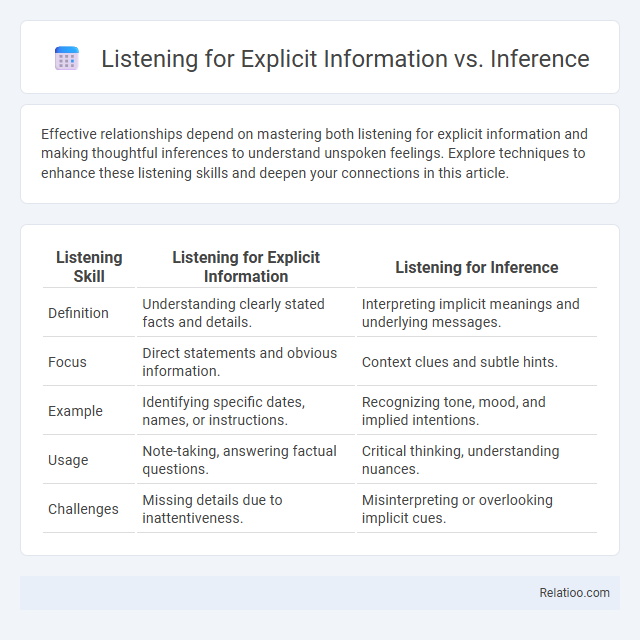Effective relationships depend on mastering both listening for explicit information and making thoughtful inferences to understand unspoken feelings. Explore techniques to enhance these listening skills and deepen your connections in this article.
Table of Comparison
| Listening Skill | Listening for Explicit Information | Listening for Inference |
|---|---|---|
| Definition | Understanding clearly stated facts and details. | Interpreting implicit meanings and underlying messages. |
| Focus | Direct statements and obvious information. | Context clues and subtle hints. |
| Example | Identifying specific dates, names, or instructions. | Recognizing tone, mood, and implied intentions. |
| Usage | Note-taking, answering factual questions. | Critical thinking, understanding nuances. |
| Challenges | Missing details due to inattentiveness. | Misinterpreting or overlooking implicit cues. |
Introduction to Listening Skills
Listening for explicit information involves identifying clear, directly stated facts or details within spoken content, essential for accurate comprehension. Inference in listening requires interpreting implicit messages, drawing logical conclusions beyond the explicit words to understand underlying meanings or intentions. Developing strong listening skills balances recognizing both explicit information and making inferences, enhancing overall communication effectiveness and critical thinking.
Defining Explicit Information in Listening
Explicit information in listening refers to facts and details clearly stated by the speaker without requiring interpretation or guesswork. Your ability to identify explicit information relies on recognizing direct statements, specific data, or unambiguous expressions within the audio content. Mastering this skill enhances comprehension and ensures accurate understanding of the speaker's intended message.
Understanding Inference in Listening
Understanding inference in listening enables you to grasp meanings that are not directly stated, relying on contextual clues and tone to interpret underlying messages. Unlike explicit information, which is clearly articulated, inference requires recognizing subtle hints and connecting ideas beyond the spoken words. Mastering inference improves comprehension and allows deeper engagement with spoken content in conversations, lectures, or media.
Key Differences: Explicit Information vs Inference
Listening for explicit information involves identifying clear, direct statements or facts presented in the audio, whereas inference requires you to interpret underlying meanings or draw conclusions not overtly stated. Explicit information is concrete and easily verifiable, while inference depends on context, tone, and prior knowledge to understand implied messages. Your ability to distinguish between these two enhances comprehension and critical listening skills.
Importance of Distinguishing Explicit and Implicit Messages
Distinguishing between explicit information and inference is crucial for effective listening, as explicit messages convey clear, direct facts while inferences involve interpreting underlying meanings or intentions. Recognizing explicit content ensures accurate comprehension, whereas understanding implicit messages requires critical thinking and context analysis to grasp subtleties. Mastery of this distinction enhances communication skills by preventing misunderstandings and enabling deeper insight into speakers' true intentions and emotions.
Strategies for Identifying Explicit Information
Identifying explicit information involves focusing on clear, directly stated facts or details in spoken content, such as names, dates, and specific instructions. Strategies include actively highlighting key words, taking concise notes, and summarizing points to ensure precise understanding without assumptions. By sharpening your ability to discern explicit messages, you improve comprehension and effective communication in various listening contexts.
Techniques for Making Accurate Inferences
Effective listening for explicit information requires focusing on clear, direct statements and verifying key details such as dates, names, and facts. Techniques for making accurate inferences involve analyzing context clues, tone, and implied meanings to understand the speaker's intent beyond the literal words. Enhancing your listening skills by integrating both explicit data and inferred insights leads to better comprehension and more nuanced communication.
Common Challenges in Listening for Different Types of Information
Listening for explicit information requires focusing on clear, direct statements, but you may struggle with missing crucial details if your attention wavers. Inferencing involves interpreting implied meanings or reading between the lines, which can be challenging due to ambiguous language or unfamiliar context. Your ability to differentiate and balance listening for both explicit data and inferences improves comprehension, especially when managing complex or nuanced conversations.
Practical Exercises to Improve Listening Skills
Practicing explicit information listening exercises, such as identifying specific facts and details in audio clips, helps build a foundation for accurate comprehension. Engaging in inference-based activities, like predicting meaning from context or interpreting tone and implied meanings, sharpens the ability to read between the lines. Combining both types of exercises enhances overall listening skills by promoting attentive, critical analysis of spoken language in realistic scenarios.
Conclusion: Enhancing Comprehension through Balanced Listening
Balancing listening for explicit information and inference strengthens your comprehension by allowing you to grasp both clear facts and implied meanings. Explicit listening captures concrete data such as dates or names, while inference involves interpreting tone, context, and unstated ideas to form conclusions. Developing skills in both areas enhances your ability to understand complex messages and respond effectively in diverse communication settings.

Infographic: Listening for Explicit Information vs Inference
 relatioo.com
relatioo.com